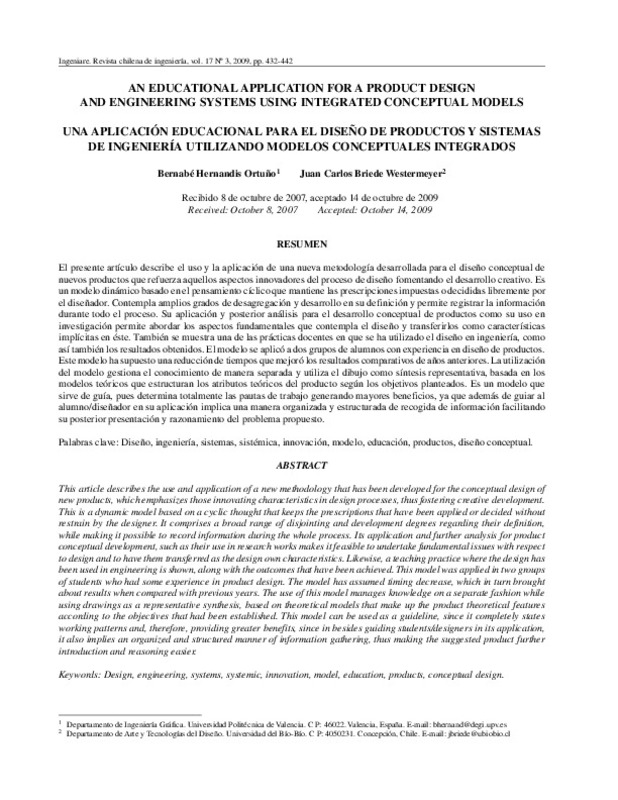JavaScript is disabled for your browser. Some features of this site may not work without it.
Buscar en RiuNet
Listar
Mi cuenta
Estadísticas
Ayuda RiuNet
Admin. UPV
An Educatonal Application for a Product design and Engineering systems using integrated conceptual models
Mostrar el registro sencillo del ítem
Ficheros en el ítem
| dc.contributor.author | Hernandis Ortuño, Bernabé
|
es_ES |
| dc.contributor.author | Briede Westermeyer, Juan Carlos
|
es_ES |
| dc.date.accessioned | 2020-02-07T21:02:22Z | |
| dc.date.available | 2020-02-07T21:02:22Z | |
| dc.date.issued | 2009 | es_ES |
| dc.identifier.uri | http://hdl.handle.net/10251/136475 | |
| dc.description.abstract | [ES] This article describes the use and application of a new methodology that has been developed for the conceptual design of new products, which emphasizes those innovating characteristics in design processes, thus fostering creative development. This is a dynamic model based on a cyclic thought that keeps the prescriptions that have been applied or decided without restrain by the designer. It comprises a broad range of disjointing and development degrees regarding their definition, while making it possible to record information during the whole process. Its application and further analysis for product conceptual development, such as their use in research works makes it feasible to undertake fundamental issues with respect to design and to have them transferred as the design own characteristics. Likewise, a teaching practice where the design has been used in engineering is shown, along with the outcomes that have been achieved. This model was applied in two groups of students who had some experience in product design. The model has assumed timing decrease, which in turn brought about results when compared with previous years. The use of this model manages knowledge on a separate fashion while using drawings as a representative synthesis, based on theoretical models that make up the product theoretical features according to the objectives that had been established. This model can be used as a guideline, since it completely states working patterns and, therefore, providing greater benefits, since in besides guiding students/designers in its application, it also implies an organized and structured manner of information gathering, thus making the suggested product further introduction and reasoning easier | es_ES |
| dc.description.abstract | [EN] This article describes the use and application of a new methodology that has been developed for the conceptual design of new products, which emphasizes those innovating characteristics in design processes, thus fostering creative development. This is a dynamic model based on a cyclic thought that keeps the prescriptions that have been applied or decided without restrain by the designer. It comprises a broad range of disjointing and development degrees regarding their definition, while making it possible to record information during the whole process. Its application and further analysis for product conceptual development, such as their use in research works makes it feasible to undertake fundamental issues with respect to design and to have them transferred as the design own characteristics. Likewise, a teaching practice where the design has been used in engineering is shown, along with the outcomes that have been achieved. This model was applied in two groups of students who had some experience in product design. The model has assumed timing decrease, which in turn brought about results when compared with previous years. The use of this model manages knowledge on a separate fashion while using drawings as a representative synthesis, based on theoretical models that make up the product theoretical features according to the objectives that had been established. This model can be used as a guideline, since it completely states working patterns and, therefore, providing greater benefits, since in besides guiding students/designers in its application, it also implies an organized and structured manner of information gathering, thus making the suggested product further introduction and reasoning easier | es_ES |
| dc.language | Inglés | es_ES |
| dc.publisher | SciELO Comision Nacional de Investigacion Cientifica Y Tecnologica | es_ES |
| dc.relation.ispartof | Ingeniare. Revista chilena de ingeniería (Online) | es_ES |
| dc.rights | Reconocimiento (by) | es_ES |
| dc.subject | Diseño | es_ES |
| dc.subject | Ingeniería | es_ES |
| dc.subject | Sistemas | es_ES |
| dc.subject | Sistémica | es_ES |
| dc.subject | Innovación | es_ES |
| dc.subject | Modelo | es_ES |
| dc.subject | Educación | es_ES |
| dc.subject | Productos | es_ES |
| dc.subject | Diseño conceptual | es_ES |
| dc.subject | Design | es_ES |
| dc.subject | Engineering | es_ES |
| dc.subject | Systems | es_ES |
| dc.subject | Systemic | es_ES |
| dc.subject | Innovation | es_ES |
| dc.subject | Model | es_ES |
| dc.subject | Education | es_ES |
| dc.subject | Products | es_ES |
| dc.subject | Conceptual design | es_ES |
| dc.subject.classification | EXPRESION GRAFICA EN LA INGENIERIA | es_ES |
| dc.title | An Educatonal Application for a Product design and Engineering systems using integrated conceptual models | es_ES |
| dc.title.alternative | Una aplicación educacional para el diseño de productos y sistemas de ingeniería utilizando modelos conceptuales integrados | es_ES |
| dc.type | Artículo | es_ES |
| dc.rights.accessRights | Abierto | es_ES |
| dc.contributor.affiliation | Universitat Politècnica de València. Departamento de Ingeniería Gráfica - Departament d'Enginyeria Gràfica | es_ES |
| dc.description.bibliographicCitation | Hernandis Ortuño, B.; Briede Westermeyer, JC. (2009). An Educatonal Application for a Product design and Engineering systems using integrated conceptual models. Ingeniare. Revista chilena de ingeniería (Online). 17(3):432-442. http://hdl.handle.net/10251/136475 | es_ES |
| dc.description.accrualMethod | S | es_ES |
| dc.relation.publisherversion | https://www.ingeniare.cl/index.php?option=com_ingeniare&view=vv&vid=66&lang=en | es_ES |
| dc.description.upvformatpinicio | 432 | es_ES |
| dc.description.upvformatpfin | 442 | es_ES |
| dc.type.version | info:eu-repo/semantics/publishedVersion | es_ES |
| dc.description.volume | 17 | es_ES |
| dc.description.issue | 3 | es_ES |
| dc.identifier.eissn | 0718-3305 | es_ES |
| dc.relation.pasarela | S\38307 | es_ES |






